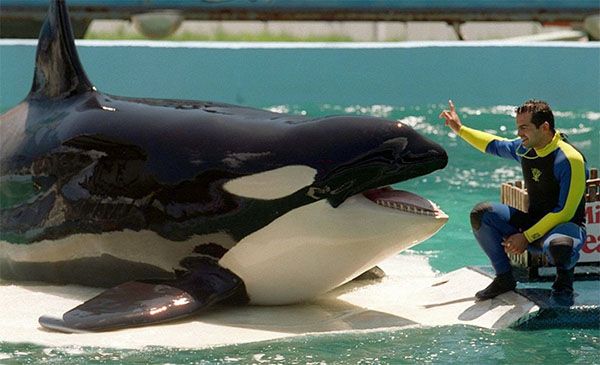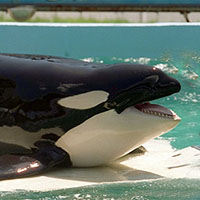‘Empty all the tanks’ and bring them home
— from Seattle Times —

In the region that brought the world its first live captive orca entertainment, a nonprofit wants to help end it forever.
The Whale Sanctuary Project, holding public meetings throughout the region this month, wants to build a $15 million netted-off cove and care facility in the San Juan Islands where captive, performing orcas can retire. The project would start with six to eight orcas.
“We owe them this,” said project Executive Director Charles Vinick, of Santa Barbara, California. “They have entertained millions of people and made millions of dollars for the people that house them and we should give them back the quality of life they so deserve.”
But a steep regulatory battle for permits lies ahead, and that is just for starters. Millions of dollars would need to be raised. And orcas make money for the aquariums where they already live.
The craze for captive performing killer whales all started with Namu. Ted Griffin brought Namu to his waterfront aquarium in Seattle in 1965, where he taught the orca to perform tricks for tourists. Namu was a worldwide sensation and soon Griffin was filling orders for killer whales captured in Puget Sound and shipped all over the world.
A generation of southern resident killer whales was taken from Puget Sound during the capture era from the mid-1960s through 1976, when a legal settlement barred SeaWorld from collecting orcas from Washington waters ever again.
All of the southern resident orcas captured are dead today but one: Lolita, taken from Penn Cove in August 1970. She has performed at the Seaquarium in Miami ever since. Corky, a northern resident captured in Pender Harbour, B.C., in 1969, has lived the longest of any orca in captivity, and is today at Sea World’s theme park in San Diego.
For orcas that were born in captivity or have been in captivity most of their lives, the sanctuary could provide a humane alternative, Vinick said. “This is a bit of a halfway house for these animals that in the main cannot be returned to the wild; this is an alternative that can give them some quality of life,” he said.
Envisioned is a netted-off natural cove, from 60 to 100 acres in size. The orcas would be fed and cared for and never have to perform again. The facility also could provide emergency response and short-term rehabilitation for wild orcas, Vinick said.
But the primary goal of the sanctuary is to start what he hopes is a growing movement, to do for orcas what already has been done for elephants, great apes and big cats, Vinick said. “We are looking to create a model sanctuary in North America to demonstrate to others this can be done.”
The project envisions spending about $15 million to build the facility and another $2 million a year to run it, including veterinary staff. The goal is to move the first orca to the facility by the end of 2020, or early 2021.
READ FULL ARTICLE: https://www.seattletimes.com/seattle-news/environment/empty-all-the-tanks-group-proposes-sanctuary-in-san-juan-islands-to-retire-captive-killer-whales/
**If you are reading theOrcasonian for free, thank your fellow islanders. If you would like to support theOrcasonian CLICK HERE to set your modestly-priced, voluntary subscription. Otherwise, no worries; we’re happy to share with you.**









According to Joe Gaydos, bringing captive orcas back to Salish Sea waters might meaning bringing back with them bacteria and viruses to which the native population would not have resistance. So the returnees would have to be quarantined from the natives, which might prove difficult, given their communication skills.